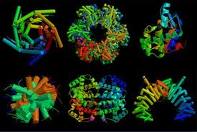背景:小种群的抽样偏差会导致一种被称为“遗传漂变”的非适应性演化现象。
研究方法:通过比较多个物种的基因组编码区,Ariel Fernández 和 Michael Lynch发现,稳定性稍差的蛋白质可在小种群内出现,这些蛋白随后可通过“蛋白-蛋白”相互作用重新变稳定,重新组合的蛋白质复合体可以演化成有意义的生物化学通道。
推测:复杂的蛋白架构和相互作用是复杂表现型的必要因素,而这些功能最初可能是通过非适应性机制形成的。
蛋白质的演变是非定向的
生物探索推荐英文摘要
Non-adaptive origins of interactome complexity
Abstract: The boundaries between prokaryotes, unicellular eukaryotes and multicellular eukaryotes are accompanied by orders-of-magnitude reductions in effective population size, with concurrent amplifications of the effects of random genetic drift and mutation1. The resultant decline in the efficiency of selection seems to be sufficient to influence a wide range of attributes at the genomic level in a non-adaptive manner2. A key remaining question concerns the extent to which variation in the power of random genetic drift is capable of influencing phylogenetic diversity at the subcellular and cellular levels2, 3, 4. Should this be the case, population size would have to be considered as a potential determinant of the mechanistic pathways underlying long-term phenotypic evolution. Here we demonstrate a phylogenetically broad inverse relation between the power of drift and the structural integrity of protein subunits. This leads to the hypothesis that the accumulation of mildly deleterious mutations in populations of small size induces secondary selection for protein–protein interactions that stabilize key gene functions. By this means, the complex protein architectures and interactions essential to the genesis of phenotypic diversity may initially emerge by non-adaptive mechanisms.








